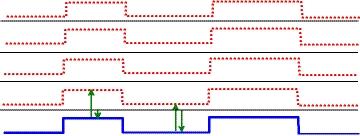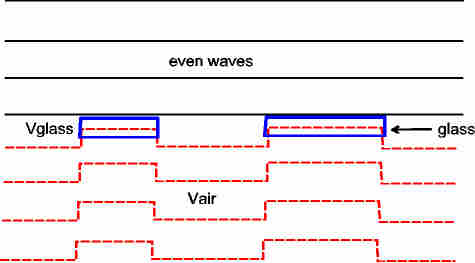 Deutsch Deutsch |
Surface defects at optical devices |
| Surface defects The affect of surface defects at optical devices results differently on the interaction with light. Assuming a mirror, the path difference at a depression is twice of the distance, resulting in time delay of the wave fronts (right arrows). If your defect is a peak, the wavefront will progress with a appropriate time difference (left arrows).  Fig. 7: Run time error at the mirror In case of glass depression the optical path is shortened in the medium. Here however the different propagation speed of the light has to be considered. In order to simplify the problem you can reduce the upper design to the lower, without making an error:  Fig. 8: Distorted glass surface as well as their simplification  Fig 9: Distorted wave front by different propagation speed in the glass. Compute: (a1): Sair = Vair* Δt (a2): Sglass = Vglass*Δt (a3): ΔS = Sair - Sglass = Vair*Δt - Vglass*Δt (a4): ΔS =Δt *(Vair - Vglass) = Vair*Δt*( 1- Vglass /Vair ) with the refractive index (a5): n = Vair /Vglass follows for the glass error: (a6): ΔSglass = Vair*Δt*(1 - 1/n) and for the mirror error: (a7): ΔSmirror = 2*Vair*Δt You receive: (a8): ΔSglass /ΔSmirror = (1 - 1/n)/2 If you assume a refractive index n = 1.5, then follows: (a9): ΔSglass /ΔSmirror = 1/6 A mirror error is affected in this case by the factor of six. |
|
| Copyright by Hans Joachim Ilgen since 1950 | |